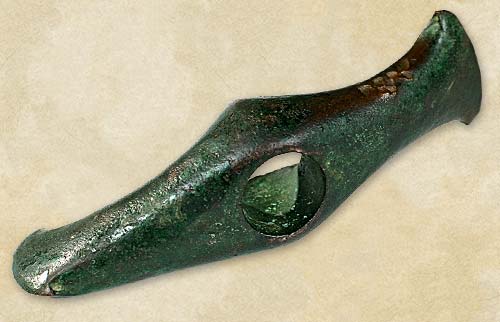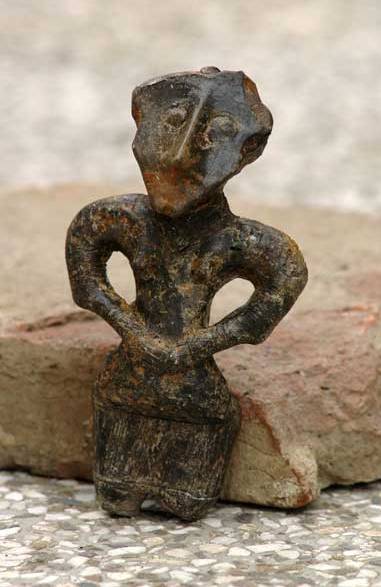The Earliest Use of Copper
The Neolithic or New Stone Age is considered to have ended from between 4500 BCE to 2000 BCE, depending on the region, and it was followed by the Bronze Age. However, before the use of bronze, an alloy of copper with other metals, was used to make tools. There was a transition period, when copper was used to make ornaments, utensils, tools and weapons. This period may be referred to as the Chalcolithic or Copper Age. Gold and copper are two metals that may be found in their native state. Even before it was understood how to melt the metals, they were beaten to form various objects. The earliest use of these metals appears to be for making beads and pins, and this was achieved even before the invention of pottery.[1] A copper pendant found in northern Iraq is said to have been dated to 8700 BCE[2]. A copper bead, dated 8200 BCE was uncovered at Urfa-Nevali, Çori, Turkey and a cylindrical copper bead dating from ca. 6000 BCE was found at Merhgarh in the Indus Valley of ancient India[4]. Recent discoveries indicate that copper was used by the Vinča culture in Serbia as early as the 5th millennium BCE and that they were perhaps the first people in the world to smelt copper in order to cast it.
Vinča copper idol produced by beating.
Photograph in the public domain.
Cast copper tools have been recovered from various parts of many locations across the central Balkans dating from the 5th millennium BCE.
 Late Cucuteni-Tripolye culture copper axe head.
Late Cucuteni-Tripolye culture copper axe head.
Attributed to the National Museum of Moldova.
Some of the native copper may contain various other metals and the artesans would have found that they were capable of being cast more easily and would hold the sharp edges longer on tools. These native alloys may have included arsenic, antimony, tin or lead. A particularly interesting hoard of copper was found in a cave at Nahal Mishmar, in the Judean Desert, Israel. It includes many beautifully executed castings dated from the early 4th millennium BCE in the Chalcolithic period. These pieces were found to have up to 20% of arsenic and antimony in the alloy. This could be considered a typical transition from copper to bronze.
Copper-alloy standard from Nahal Mishmar, L. 18.5 cm.
On loan from the Israel Antiquities Authority (L.1994.74.6)
Photograph attributed to the Metropolitan Museum of Art.
Because copper and its alloys would be hard to differentiate, especially before the technology of making alloys was widely understood, these metals were all known in Roman times by the Latin name of Aes making it difficult to know exactly, which metals were being referred to in Roman records kept dating back to the first millennium BCE. In modern times copper ware is still produced by craftsmen in places like Uttarkhand in northern India and Nepal.
1. Ünsal Yalçın & Hadi Özbal, History of Mining and Metallurgy In Anatolia. www.kimya.boun.edu.tr/webpages/courses/sts302/Anatolian_Metallurgy_STS_302.pdf
2. Rayner W. Hesse (2007). Jewelrymaking through History: an Encyclopedia. Greenwood Publishing. p. 56.
3. Philip P. Betancourt The Chrysokamino Metallurgy Workshop and It’s Territory, Ch. 13 Early Anatolian Metallurgy p.161, The American School of Classical Studies at Athens, 2006.
4. Rina Shrivastva, Mining of Copper in Ancient India. Indian Journal of History of Science, 34(3), 1999.

